 W
WTwelfth century European fashion was simple and differed only in details from the clothing of the preceding centuries. Men wore knee-length tunics for most activities, and men of the upper classes wore long tunics, with hose and mantle or cloaks. Women wore long tunics or dresses. A close fit to the body, full skirts, and long flaring sleeves were characteristic of upper-class fashion for both men and women.
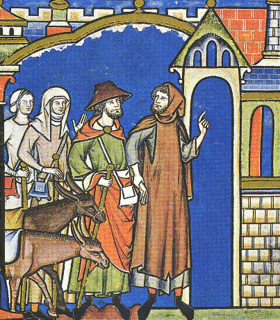 W
WCostume during the thirteenth century in Europe was very simple for both men and women, and quite uniform across the continent. Male and female clothing were relatively similar, and changed very slowly, if at all. Most clothing, especially outside the wealthier classes, remained little changed from three or four centuries earlier. The century saw great progress in the dyeing and working of wool, which was by far the most important material for outerwear. For the rich, colour and rare fabrics such as silk from the silkworm was very important. Blue was introduced and became very fashionable, being adopted by the Kings of France as their heraldic colour.
 W
WFashion in fourteenth-century Europe was marked by the beginning of a period of experimentation with different forms of clothing. Costume historian James Laver suggests that the mid-14th century marks the emergence of recognizable "fashion" in clothing, in which Fernand Braudel concurs. The draped garments and straight seams of previous centuries were replaced by curved seams and the beginnings of tailoring, which allowed clothing to more closely fit the human form. Also, the use of lacing and buttons allowed a more snug fit to clothing.
 W
WFashion in 15th-century Europe was characterized by a series of extremes and extravagances, from the voluminous robes called houppelandes with their sweeping floor-length sleeves to the revealing doublets and hose of Renaissance Italy. Hats, hoods, and other headdresses assumed increasing importance, and were draped, jewelled, and feathered.
 W
WFashion in the period 1500–1550 in Western Europe is marked by voluminous clothing worn in an abundance of layers. Contrasting fabrics, slashes, embroidery, applied trims, and other forms of surface ornamentation became prominent. The tall, narrow lines of the late Medieval period were replaced with a wide silhouette, conical for women with breadth at the hips and broadly square for men with width at the shoulders. Sleeves were a centre of attention, and were puffed, slashed, cuffed, and turned back to reveal contrasting linings.
 W
WFashion in the period 1550–1600 in Western European clothing was characterized by increased opulence. Contrasting fabrics, slashes, embroidery, applied trims, and other forms of surface ornamentation remained prominent. The wide silhouette, conical for women with breadth at the hips and broadly square for men with width at the shoulders had reached its peak in the 1530s, and by mid-century a tall, narrow line with a V-lined waist was back in fashion. Sleeves and women's skirts then began to widen again, with emphasis at the shoulder that would continue into the next century. The characteristic garment of the period was the ruff, which began as a modest ruffle attached to the neckband of a shirt or smock and grew into a separate garment of fine linen, trimmed with lace, cutwork or embroidery, and shaped into crisp, precise folds with starch and heated irons.
 W
WFashion in the period 1600–1650 in Western European clothing is characterized by the disappearance of the ruff in favour of broad lace or linen collars. Waistlines rose through the period for both men and women. Other notable fashions included full, slashed sleeves and tall or broad hats with brims. For men, hose disappeared in favour of breeches.
 W
WFashion in the period 1650–1700 in Western European clothing is characterized by rapid change. The style of this era is known as Baroque. Following the end of the Thirty Years' War and the Restoration of England's Charles II, military influences in men's clothing were replaced by a brief period of decorative exuberance which then sobered into the coat, waistcoat and breeches costume that would reign for the next century and a half. In the normal cycle of fashion, the broad, high-waisted silhouette of the previous period was replaced by a long, lean line with a low waist for both men and women. This period also marked the rise of the periwig as an essential item of men's fashion.
 W
WFashion in the period 1690–1740 in European and European-influenced countries is characterized by a widening silhouette for both men and women following the tall, narrow look of the 1680s and 90s. This era is defined as late Baroque/Rococo style. The new fashion trends introduced during this era had a greater impact on society, affecting not only royalty and aristocrats, but also middle and even lower classes. Clothing during this time can be characterized by soft pastels, light, airy, and asymmetrical designs, and playful styles. Wigs remained essential for men and women of substance, and were often white; natural hair was powdered to achieve the fashionable look. The costume of the eighteenth century, if lacking in the refinement and grace of earlier times, was distinctly quaint and picturesque.
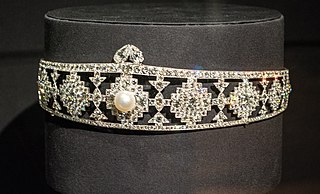 W
WA bandeau is a garment comprising, in appearance, a strip of cloth. Today, the term frequently refers to a garment that wraps around a woman's breasts. It is usually part of a bikini in sports or swimwear. It is similar to a tube top, but narrower. It is usually strapless, sleeveless, and off the shoulder. Bandeaux are commonly made from elastic material to stop them from slipping down, or are tied or pinned at the back or front. In the first half of the 20th century, a "bandeau" was a narrow band worn by women to bind the hair, or as part of a headdress.
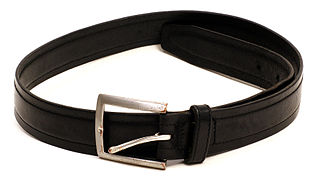 W
WA belt is a flexible band or strap, typically made of leather, plastic, or heavy cloth, worn around the natural waist or near it. The ends of a belt are free; and a buckle forms the belt into a loop by securing one end to another part of the belt, at or near the other end. Often, the resulting loop is smaller than the hips. Belts come in many lengths because of the variety in waist sizes, and most belts can be adjusted at the buckle to suit the wearer's waist.
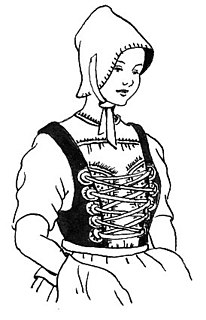 W
WA bodice is an article of clothing for women and girls, covering the torso from the neck to the waist. The term typically refers to a specific type of upper garment common in Europe during the 16th to the 18th century, or to the upper portion of a modern dress to distinguish it from the skirt and sleeves. The name bodice comes from an older garment called a pair of bodies.
 W
WBonnet has been used as the name for a wide variety of headgear for all sexes—more often female—from the Middle Ages to the present. As with "hat" and "cap", it is impossible to generalize as to the styles for which the word has been used, but there is for both sexes a tendency to use the word for pop styles in soft material and lacking a brim, or at least one all the way round, rather than just at the front. Yet the term has also been used, for example, for steel helmets. This was from Scotland, where the term has long been especially popular.
 W
WBraies are a type of trouser worn by Celtic and Germanic tribes in antiquity and by Europeans subsequently into the Middle Ages. In the later middle ages they were used exclusively as undergarments. Braies generally hung to the knees or mid-calf, resembling what are today called shorts. They were made of leather, wool, or, in later years, cotton or linen. They were adopted by the Romans as braccae.
 W
WBreeches are an article of clothing covering the body from the waist down, with separate coverings for each leg, usually stopping just below the knee, though in some cases reaching to the ankles. The breeches were normally closed and fastened about the leg, along its open seams at varied lengths, and to the knee, by either buttons or by a drawstring, or by one or more straps and buckle or brooches. Formerly a standard item of Western men's clothing, they had fallen out of use by the mid-19th century in favour of trousers.
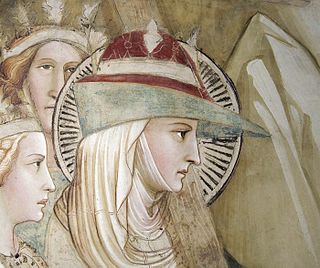 W
WA bycocket or bycoket is a style of hat that was fashionable for both men and women in Western Europe from the 13th to the 16th century. It has a wide brim that is turned up in the back and pointed in the front like a bird's beak. In French, it is called a chapeau à bec due to this resemblance.
 W
WA cape is a clothing accessory or a sleeveless outer garment which drapes the wearer's back, arms, and chest, and connects at the neck.
 W
WA Chaperon was a form of hood or, later, highly versatile hat worn in all parts of Western Europe in the Middle Ages. Initially a utilitarian garment, it first grew a long partly decorative tail behind called a liripipe, and then developed into a complex, versatile and expensive headgear after what was originally the vertical opening for the face began to be used as a horizontal opening for the head. It was especially fashionable in mid-15th century Burgundy, before gradually falling out of fashion in the late 15th century and returning to its utilitarian status. It is the most commonly worn male headgear in Early Netherlandish painting, but its complicated construction is often misunderstood.
 W
WA chemise or shift is a classic smock, or a modern type of women's undergarment or dress. Historically, a chemise was a simple garment worn next to the skin to protect clothing from sweat and body oils, the precursor to the modern shirts commonly worn in Western nations.
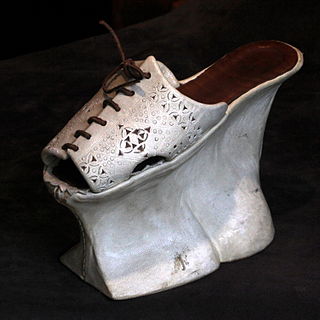 W
WA chopine is a type of women's platform shoe that was popular in the 15th, 16th and 17th centuries. Chopines were originally used as a patten, clog, or overshoe to protect the shoes and dress from mud and street soil.
 W
WA cloak is a type of loose garment that is worn over indoor clothing and serves the same purpose as an overcoat; it protects the wearer from the cold, rain or wind for example, or it may form part of a fashionable outfit or uniform. Cloaks have been used by myriad historic societies; many climates favor wearing a full-body garment which is easily removed and does not constrain the wearer with sleeves. Over time cloak designs have been changed to match fashion and available textiles.
 W
WA coat is a garment worn on the upper body by either gender for warmth or fashion. Coats typically have long sleeves and are open down the front, closing by means of buttons, zippers, hook-and-loop fasteners, toggles, a belt, or a combination of some of these. Other possible features include collars, shoulder straps and hoods.
 W
WA codpiece is a covering flap or pouch that attaches to the front of the crotch of men's trousers, enclosing the genital area. It may be held closed by string ties, buttons, folds, or other methods. It was an important fashion item of European clothing during the fifteenth and sixteenth centuries. In the modern era, clothing devices with similar functions as codpieces are worn in some styles of underwear, in the leather subculture, and in performance costumes, such as for rock music and metal musicians. A similar device with rigid construction, an athletic cup, is used as protective underwear for male athletes.
 W
WA coif is a close fitting cap worn by both men and women that covers the top, back, and sides of the head.
 W
WA corset is a support garment commonly worn to hold and train the torso into a desired shape, traditionally a smaller waist or larger bottom, for aesthetic or medical purposes, or support the breasts. Both men and women are known to wear corsets, though this item was for many years an integral part of women's wardrobes.
 W
WCrakows or crackowes were a style of shoes with extremely long toes very popular in 15th century Europe. They were so named because the style was thought to have originated in Kraków, then the capital of Poland. They are also known as poulaines or pikes, though the term poulaine, as in souliers à la poulaine, "shoes in the Polish fashion", referred to the long pointed beak of the shoe, not the shoe itself.
 W
WA disc fibula or disc brooch is a type of fibula, that is, a brooch, clip or pin used to fasten clothing that has a disc-shaped, often richly decorated plate or disc covering the fastener. The terms are mostly used in relation to the Middle Ages of Europe, especially the earlier part of the period. They were the most common style of Anglo-Saxon brooches.
 W
WA doublet is a man's snug-fitting jacket that is shaped and fitted to the man's body which was worn in Spain and was spread to Western Europe from the late Middle Ages up to the mid-17th century. The doublet was hip length or waist length and worn over the shirt or drawers. Until the end of the 15th century, the doublet was usually worn under another layer of clothing such as a gown, mantle, overtunic or jerkin when in public.
 W
WEarly medieval European dress, from about 400 to 1100, changed very gradually. The main feature of the period was the meeting of late Roman costume with that of the invading peoples who moved into Europe over this period. For a period of several centuries, people in many countries dressed differently depending on whether they identified with the old Romanised population, or the new populations such as Franks, Anglo-Saxons, Visigoths. The most easily recognisable difference between the two groups was in male costume, where the invading peoples generally wore short tunics, with belts, and visible trousers, hose or leggings. The Romanised populations, and the Church, remained faithful to the longer tunics of Roman formal costume, coming below the knee, and often to the ankles. By the end of the period, these distinctions had finally disappeared, and Roman dress forms remained mainly as special styles of clothing for the clergy – the vestments that have changed relatively little up to the present day.
 W
WA garter is an article of clothing comprising a narrow band of fabric fastened about the leg to keep up stockings. In the eighteenth to twentieth centuries, they were tied just below the knee, where the leg is most slender, to keep the stocking from slipping. The advent of elastic has made them less necessary from this functional standpoint, although they are still often worn for fashion. Garters have been widely worn by men and women, depending on fashion trends.
 W
WGirdle books were small portable books worn by medieval European monks, clergymen and aristocratic nobles as a popular accessory to medieval costume, between the 13th and 16th centuries. They consisted of a book whose leather binding continued loose below the cover of the book in a long tapered tail with a large knot at the end which could be tucked into one's girdle or belt. The knot was usually strips of leather woven together for durability. The book hung upside down and backwards so that when swung upwards it was ready for reading. The books were normally religious: a cleric's daily Office, or for lay persons a Book of Hours. One of the best known texts to become a girdle book is Boethius's The Consolation of Philosophy, although it is the only surviving philosophical/theological girdle book.
 W
WA gown, from the Saxon word, gunna, is a usually loose outer garment from knee- to full-length worn by men and women in Europe from the Early Middle Ages to the 17th century, and continuing today in certain professions; later, gown was applied to any full-length woman's garment consisting of a bodice and attached skirt. A long, loosely fitted gown called a Banyan was worn by men in the 18th century as an informal coat.
 W
WThe guimpe was a garment which developed in medieval Western Europe. It was a silk or linen kerchief, sometimes sheer, sometimes starched, which covered the neck and shoulders of the wearer, sometimes the entire chest as well. It was worn as part of the garb of a woman of means, both to show social standing—due to the added upkeep it required—and to demonstrate the woman's sense of modesty. Among nuns it was worn in combination with a coif and wimple.
 W
WA hangaroc was an apron-like outer garment worn by women of Norse origins in the 8th, 9th and 10th centuries. In its usual form the hangaroc comprised a woollen or linen tailored tube wrapped around the body under the armpits and suspended by a pair of cloth straps that ran over the shoulders. It hung down to mid-calf.
 W
WThe hennin was a headdress in the shape of a cone, steeple, or truncated cone worn in the late Middle Ages by European women of the nobility. They were most common in Burgundy and France, but also elsewhere, especially at the English courts, and in Northern Europe, Hungary and Poland. They are little seen in Italy. It is unclear what styles the word hennin described at the time, though it is recorded as being used in French in 1428, probably before the conical style appeared. The word does not appear in English until the 19th century. The term is therefore used by some writers on costume for other female head-dresses of the period.
 W
WA herigaut is a gown-like garment worn in the thirteenth and early fourteenth centuries. Alternative spellings include herigald, heregaud, gerygoud and herigans. It was three-quarters to full length with hanging sleeves. Sometimes the sleeves were tucked at the top to increase fullness below. Although it was primarily a men's garment, women occasionally wore it as well. Along with the garnache, it is a variant of the garde-corps, and it is also related to the houppelande.
 W
WA hood is a kind of headgear that covers most of the head and neck, and sometimes the face. Hoods that cover mainly the sides and top of the head, and leave the face mostly or partly open may be worn for protection from the environment, for fashion, as a form of traditional dress or uniform, or in the case of knights, an armoured hood is used for protection against bladed weapons. In some cases, hoods are used to prevent the wearer from seeing where they are going. Hoods with eye holes may be used for religious purposes to prevent the wearer from being seen. In the case of Ku Klux Klan members, terrorists, or criminals such as robbers, a hood with eye holes helps prevent identification.
 W
WHose are any of various styles of men's clothing for the legs and lower body, worn from the Middle Ages through the 17th century, when the style fell out of use in favour of breeches and stockings. The old plural form of "hose" was "hosen". In German these terms remained in use and are the generic terms for trousers today. The French equivalent was chausses.
 W
WA houppelande or houpelande is an outer garment, with a long, full body and flaring sleeves, that was worn by both men and women in Europe in the late Middle Ages. Sometimes the houppelande was lined with fur. The garment was later worn by professional classes, and has remained in Western civilization as the familiar academic and legal robes of today.
 W
WA jerkin is a man's short close-fitting jacket, made usually of light-coloured leather, and often without sleeves, worn over the doublet in the sixteenth and seventeenth centuries. The term is also applied to a similar sleeveless garment worn by the British Army in the 20th century.
 W
WA kilt is a type of knee-length men’s dress skirt non-bifurcated with pleats at the back, originating in the traditional dress of Gaelic men and boys in the Scottish Highlands. It is first recorded in the 16th century as the great kilt, a full-length garment whose upper half could be worn as a cloak. The small kilt or modern kilt emerged in the 18th century, and is essentially the bottom half of the great kilt. Since the 19th century, it has become associated with the wider culture of Scotland, and more broadly with Gaelic or Celtic heritage. It is most often made of woollen cloth in a tartan pattern.
 W
WA kirtle is a garment that was worn by men and women in the Middle Ages. It eventually became a one-piece garment worn by women from the late Middle Ages into the Baroque period. The kirtle was typically worn over a chemise or smock, which acted as a slip, and under the formal outer garment or gown/surcoat.
 W
WA mantle is a type of loose garment usually worn over indoor clothing to serve the same purpose as an overcoat. Technically, the term describes a long, loose cape-like cloak worn from the 12th to the 16th century by both sexes, although by the 19th century, it was used to describe any loose-fitting, shaped outer garment similar to a cape. For example, the dolman, a 19th-century cape-like woman's garment with partial sleeves is often described as a mantle.
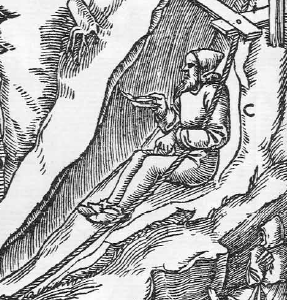 W
WThe miner's apron is part of the clothing worn, especially historically, by miners in the mining industries of German-speaking Europe. Variously called in English a miner's apron, a miner's after-apron, breech leather or miner's leather apron, it was a leather apron that served to keep the seat of the trousers from wearing out when working or moving around the mine (Fahrung) as well as keeping out the cold and moisture when sitting. It also provided protection especially when entering inclined mineshafts. Another advantage was that it stabilised the internal organs from mechanical shock and vibration by acting as a sort of kidney belt. The miner's apron was a triangular or, more rarely, semi-circular piece of leather and was supported by the body belt. In Germany the design of the modern miner's apron is governed by DIN standard 23307 Gesäßleder für den Bergbau (Arschleder).
 W
WPattens are protective overshoes that were worn in Europe from the Middle Ages until the early 20th century. Pattens were worn outdoors over a normal shoe, had a wooden or later wood and metal sole, and were held in place by leather or cloth bands. Pattens functioned to elevate the foot above the mud and dirt of the street, in a period when road and urban paving was minimal.
 W
WA petticoat or underskirt is an article of clothing, a type of undergarment worn under a skirt or a dress. Its precise meaning varies over centuries and between countries.
 W
WThe Phrygian cap or liberty cap is a soft conical cap with the apex bent over, associated in antiquity with several peoples in Eastern Europe and Anatolia, including the Balkans, Dacia, Thrace and Phrygia, where the name originated.
 W
WThe clothing worn by plague doctors was intended to protect them from airborne diseases during outbreaks of the Bubonic Plague in Europe. It is often seen as a symbol of death and disease. However, the costume was worn by a comparatively small number of medieval and early modern physicians studying and treating plague patients.
 W
WSamite was a luxurious and heavy silk fabric worn in the Middle Ages, of a twill-type weave, often including gold or silver thread. The word was derived from Old French samit, from medieval Latin samitum, examitum deriving from the Byzantine Greek ἑξάμιτον hexamiton "six threads", usually interpreted as indicating the use of six yarns in the warp. Samite is still used in ecclesiastical robes, vestments, ornamental fabrics, and interior decoration.
 W
WA skirt is the lower part of a dress or a separate outer garment that covers a person from the waist downwards.
 W
WStockings are close-fitting, variously elastic garments covering the leg from the foot up to the knee or possibly part or all of the thigh. Stockings vary in color, design, and transparency. Today, stockings are primarily worn for fashion and aesthetics, usually in association with mid-length or short skirts.
 W
WA surcoat or surcote is an outer garment that was commonly worn in the Middle Ages by both men and women in Western Europe. It can either refer to a coat worn over other clothes or the outermost garment itself. The name derives from French meaning "over the coat", a long, loose, often sleeveless coat reaching down to the feet.
 W
WA tabard is a type of short coat that was commonly worn by men during the late Middle Ages and early modern period in Europe. Generally worn outdoors, the coat was either sleeveless or had short sleeves or shoulder pieces. In its more developed form it was open at the sides, and it could be worn with or without a belt. Though most were ordinary garments, often work clothes, tabards might be emblazoned on the front and back with a coat of arms (livery), and in this form they survive as the distinctive garment of officers of arms.
 W
WTrousers, slacks, or pants are an item of clothing that might have originated in Central Asia, worn from the waist to the ankles, covering both legs separately.
 W
WA tunic is a garment for the body, usually simple in style, reaching from the shoulders to a length somewhere between the hips and the knees. The name derives from the Latin tunica, the basic garment worn by both men and women in Ancient Rome, which in turn was based on earlier Greek garments that covered wearers' waists.
 W
WA veil is an article of clothing or hanging cloth that is intended to cover some part of the head or face, or an object of some significance. Veiling has a long history in European, Asian, and African societies. The practice has been prominent in different forms in Judaism, Christianity, and Islam. The practice of veiling is especially associated with women and sacred objects, though in some cultures it is men rather than women who are expected to wear a veil. Besides its enduring religious significance, veiling continues to play a role in some modern secular contexts, such as wedding customs.
 W
WA waistcoat, or vest (US), is a sleeveless upper-body garment. It is usually worn over a dress shirt and necktie and below a coat as a part of most men's formal wear. It is also sported as the third piece in the traditional three-piece male suit. Any given vest can be simple or ornate, or for leisure or luxury. Historically, the vest can be worn either in the place of or underneath a larger coat dependent upon the weather, wearer, and setting.
 W
WA wimple is a medieval form of female headdress, formed of a large piece of cloth worn draped around the neck and chin, and covering the top of the head, it was usually made from white linen or even silk. Its use developed in early medieval Europe. At many stages of medieval Christian culture it was unseemly for a married woman to show her hair. A wimple might be elaborately starched, and creased and folded in prescribed ways, and later elaborated versions were supported on wire or wicker framing, such as the cornette.